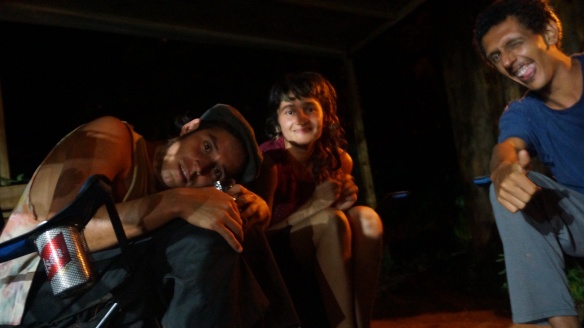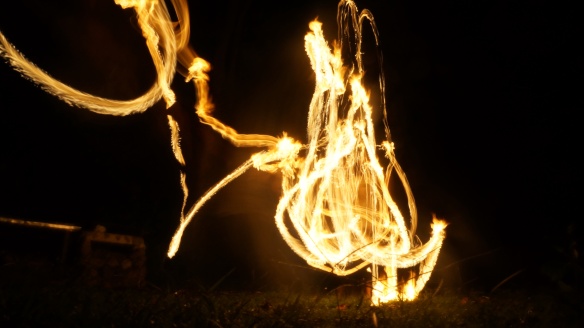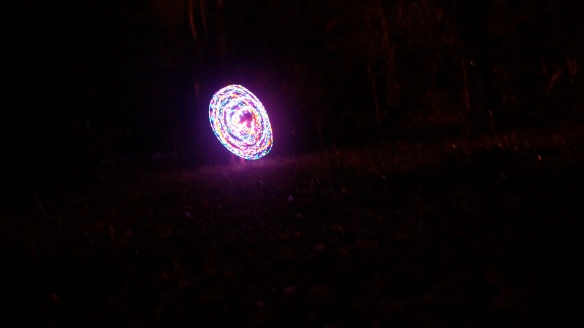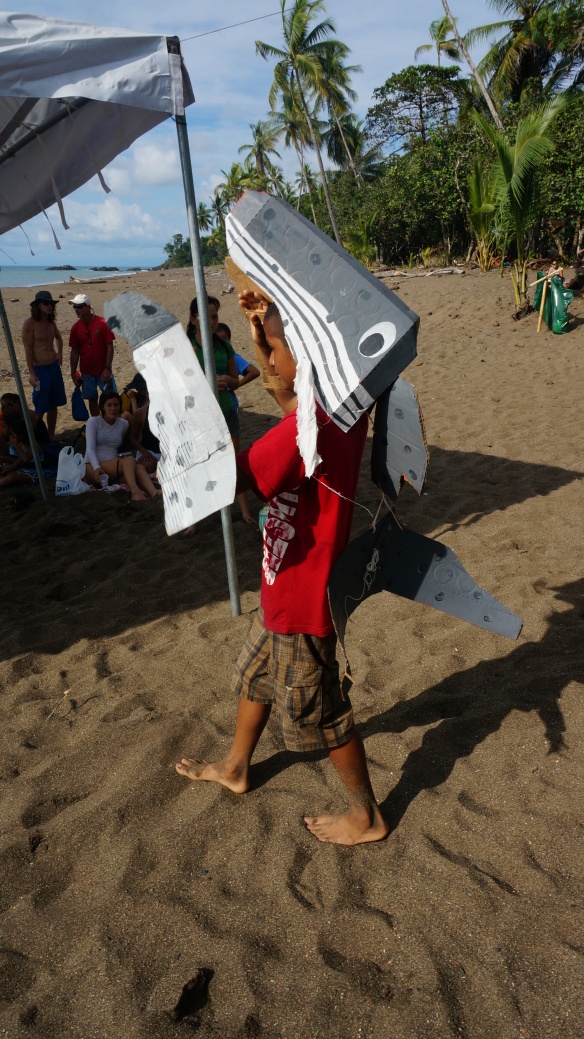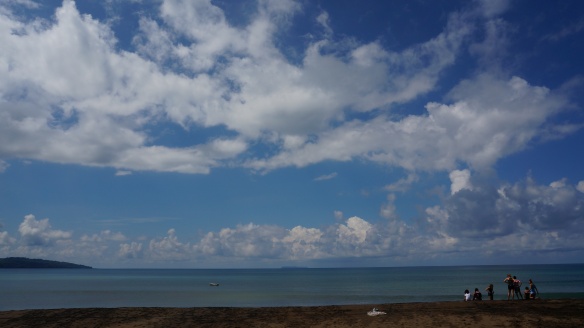
Our stint as volunteers with the Corcovado Foundation also included four nights as volunteers inside Corcovado National Park. Volunteering inside the park is a relatively new and untested opportunity offered by the foundation and Rob, the director, warned us that our duties might be mainly cleaning the ranger station as opposed to helping with any trail work. We figured we would give it a go anyway since we both wanted to get inside the park and we weren’t afraid of a little cleaning. We woke up very early on Tuesday morning so that one of the research assistants could drive us to the neighboring town of Agujitas where we would be catching a ride on a boat that the hotels use to send tourists over to the park. Other than the boat option, the only other ways to get into the Sirena Ranger Station are to walk or take a tiny 6 passenger plane.
Our boat ride that morning was beautiful. The boats pull right up to the shore line on the beach where you walk into the water and onto the boat. No docks in sight! We motored past Isla del Caño and saw dolphins swimming nearby the boat. When we arrived at the park entry (aka a break in the trees at an unmarked stretch of beach), we waded onto shore, put our shoes on and were told by the hotel employee that the Sirena Ranger station (our arranged destination) was just straight ahead. Not knowing where we were going or who we were supposed to find when we got there, we headed off into the woods. Multiple turns, and a few stream crossings later we arrived at a clearing that led to the ranger station. This 800 meter grassy clearing functioned as the landing strip for the small planes bringing people in and out of the park as well as a welcome mat for the brave hikers who make the 8 hour hike into the park from the Carate. We were pleased to see that the Sirena station was a simple, clean and well kept campsite. We pitched out tent in one of the camping areas which consisted of a raised wooden platform covered by a roof. With some difficulty we figured out who the ranger was, checked in and were told to never leave the campsite after 6PM, never be late for a meal and always tell him when we were leaving, where we were going and when we came back. After that drill sergeant-like introduction we figured we would have a schedule of tasks laid out for us to do each day, but this was absolutely not the case. We gathered that sweeping the station was to be a daily activity and other than that we basically hung around the kitchen trying to make ourselves useful. We basically created our own schedule of sweeping in the morning and cleaning the dishes after breakfast, lunch and dinner. In exchange for this work, and the $25 a day we paid to be a volunteer, we got free transport in and out of the park, three hot meals a day prepared by the station cook (which normally costs campers $70 a day) and plenty of time to get in two great hikes a day! We felt that it was a great deal.
We ended up exploring all the trails that lead out of the Sirena station except for one which the ranger told us was lacking all trail markers, had lots of downed trees blocking the trail and on which two hikers recently got lost on and had to spend the night in the forest alone. We were confused as to why we seemed to be the only ones he told about this hazardous trail but figured we wouldn’t push our luck so we avoided it. The trails are all generally safe during the day as long as you stay on them and watch where you are stepping as to not disturb any poisonous snakes. We never encountered any snakes but many groups walking with guides saw several poisonous varieties just steps from the trails. We were also bummed to not see any poison dart frogs but we really can’t complain. Over the few days we saw all types of huge iguanas and lizards, bull sharks, a gigantic Tapir, agouti, toucans, macaws, squirrel monkeys (titis), spider monkeys, howler monkeys, wild pigs, white tailed deer, crocodiles, caimans and some epically large and old trees. Instructions at the ranger station advise you to carry a walking stick which can double as a defensive device should you encounter a jaguar or a cougar on the trails. Normally these creatures don’t come out during the day, but if they do you are instructed to stand you ground, look as big as possible, and stare the cat down in the eye. If you run from one of the big cats, their instincts tell them that you are weaker than them and they should attack you because you are probably dinner. On our first hike I have to admit I was pretty nervous. Not only watching out for snakes and trying to avoid getting bitten by leaf cutter ants, but also for a potential large animal encounter. After about 5 minutes into the first hike two branches snapped and fell to the ground near us, rustling the dense forest around us. Two monkeys had a little tussle and broke a few branches, a common occurrence as we discovered. However, I immediately was convinced that the noise was the sound of a jaguar charging us and what did I do? I started running away down the trail without a walking stick. Perfect. Jordan scolded me and I tried to keep my jitters on lock from then on.





Tapir tree cave

Our first hike took us to what turned out to be our favorite spot. The Rio Claro trail leads hikers to a beautiful fresh water swimming hole. No alligators or snakes were in sight and we tried to go there every afternoon to cool off in the water for a while. Often monkeys would come to the trees at the edge of the water and one day we even saw a pigmy kingfisher bird skirting across the water. Each trail offered the hiker a different experience, from dense forest to skirting the sandy coastline. I was fascinated by the variety of fungi and mushrooms growing on the rotting logs all around the trails. Many of the fungi were delicate, tiny and a vibrant white, kind of like tropical snowflakes. The density of the tree tops and the intricacies of the gargantuan tree trunks marked the trails of primary forest and provided a shady calm environment in which you could hear all sorts of mysterious sounds. We tried to stay as quiet as possible on our hikes and several times found ourselves only feet away from monkeys and other wildlife. Other than the Jurassic sized mosquito bites we suffered, we experienced some incredible nature, met several wonderful people, and had a great time. We even walked down to the end of the landing strip a couple nights to take in the sunset. It was amazing to sit there, in the middle of the wilderness, watching the gold and amber light glistening off the sheets of volcanic rock which stretch from the sand into the water.




Feeling in touch with nature and at peace, we packed up our backpacks and made our way back to the section of beach where we would be catching our boat back to the turtle camp. When we arrived i noticed that the water was much choppier than it had been on our way in. No one else seemed to notice and the boats arrived just as before, pulling n close to the shoreline. Only this time the 2 man crew had to hold the boat steady as the waves crashed and the passengers ran and hopped into the boat before the next wave crashed and jolted the tiny boat. We all made it in and stuffed our bags in the front and off we went crashing into the waves. My nature induced calmness and serenity were immediately knocked out of me as we embarked on the most turbulent, white knuckledboat rides i’ve ever had. Jordan and I were sitting in the front row and were jolted up and down by 2-3 feet ever other second. I sat there, trying not to see the waves swelling on our left side, or the 30 foot spray from the waves crashing into the jagged rocks on our right side. After the longest hour and a half ever, I wondered where I could get either a shot of whiskey or perhaps a fresh pair of underwear as quickly as possible.
When we finally made it back to turtle camp, we enjoyed the program’s farewell barbecue and said goodbye to our new friends. We started making preparations for our next stop on the journey, the archipelago Bocas del Toro in Panama!
Has anyone else been to Corcovado or explored the other ranger stations? We would love to hear about your experience! Or, has anyone out there ever encountered a potentially dangerous creature while hiking? How did you react?






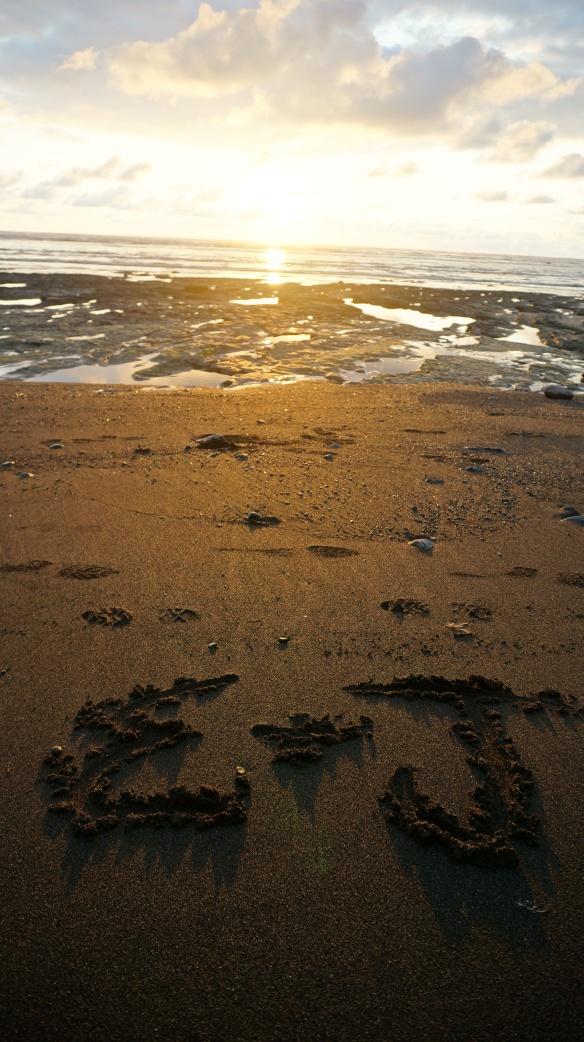

8.540835
-83.570964

